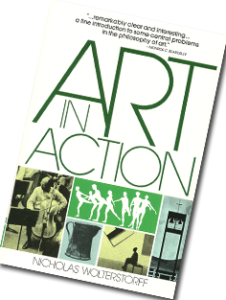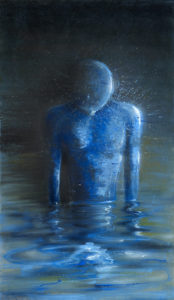Back to series


Recommended Reading:

A Reformed Vision of the Visual Arts
A Conversation with Abraham Kuyper, Nicholas Wolterstorff, and the Word of God
| The knowledge that John Calvin did not denigrate the arts comes as a shock to many people. But what truly astounds is the discovery that Reformed thought has, over time, become a great source of encouragement for the arts, including the visual arts.1 Implicit in Reformed thought’s radically beautiful understanding of grace—saving and common—and vocation, there are seeds that surprisingly perhaps have blossomed into an aesthetic vision offering amazing artistic freedom and creativity. And this vision is worth a long and lingering look.
Until the time of the Reformation, the visual arts were essentially the handmaiden of the church. Christian saints and scenes, princes and popes—these were almost always the subject matter of the visual arts. One need only walk through the Ufizzi Gallery in Florence, Italy, for proof. Madonna and Child by Duccio . . . by Cimabue . . . by Giotto. The list goes on. And even when the subject was an occasional Greek myth or such, paintings and sculpture were usually done through and for the institutional church or its wealthy patrons. Thus most visual art and the artists who received patronage lived beneath the umbrella of the church.2 A New Subject MatterImplicit in Calvinism, however, were at least two ideas that would lead to a new vision for visual arts. At the turn of the twentieth century, Abraham Kuyper, a Dutch prime minister and theologian, pointed to these in his famous essay, “Calvinism and Art.” He contended that the Reformed emphasis on grace, common and saving, was a key to artistic freedom. Common grace, God’s gifts “bestowed indiscriminately upon pious and impious” alike, was now celebrated.3 And creative or artistic ability, as Calvin had asserted, was one of those gifts. Thus Reformed thought opened the way for someone to stand outside of the people of God and produce truly valuable art work. After all, when Solomon built the Temple, he called on Hiram, king of Tyre (not a Jew), for help. And Hiram—in addition to supplying the wood for the Temple—sent along a master craftsman, Huram-Abi, whose ancestry was also questionable. But Huram-Abi was “trained to work in gold and silver, bronze and iron, stone and wood, and with purple and blue and crimson yarn and fine linen” (2 Chron. 2:14).4 He could create beautiful objects. Therefore, regardless of his religious or national affiliation, his work was celebrated. With this freedom for artistry to exist outside the church, there came a second freeing realization. God’s election by free grace comes to the least important or significant of people, regardless of status or capacity. As a result, everyday people and their lives became intrinsically valuable as subject matter. Kuyper put it this way: If a common man, to whom the world pays no special attention, is valued and even chosen by God . . . this must lead the artist also to find a motive for his artistic studies in what is common and of every-day occurrence, to pay attention to the emotion and the issues of the human heart in it, to grasp with his artistic instinct their ideal impulse, and lastly, by his pencil to interpret for the world at large the precious discovery he has made.5
Rembrandt could also paint a picture of an old pair of shoes. Vermeer could paint a picture of an everyday kitchen maid pouring water into a basin. Pieter de Hooch could paint images of a courtyard or bedroom. People everywhere were beginning to see the value in earthly as well as heavenly life. After all, not only has God given grace to common, mundane people, but even his saving grace validated this earthy world. The second Adam’s death justified God’s people. But Jesus’ life redeemed every aspect of true human existence.6 In the Word made flesh, the visible image of the invisible God intimately and experientially knew what it was to sweat, laugh, cry, and drink a little wine.7 Thus these things could be celebrated as worthy subject matter. Being HumanBeyond opening up a new freedom for the subject matter of an artistic vision, different Reformed thinkers have, particularly in the past fifty years, begun to sketch out what might be called a “Christian Aesthetic.”8 One such established thinker is Nicholas Wolterstorff. In his book Art in Action, he picks up the question of what it means to be a human being with a vocation and applies a Reformed answer to the world of the arts. Like Calvin, whose first Book in his Institutes is titled “The Knowledge of God the Creator,” Wolterstorff starts at the very beginning, turning to Genesis. There he sees a picture of the ultimate Creator in whose image we are made, but, more significantly, because art is the byproduct of human endeavor, he looks to Genesis as our starting place of understanding what it means to be human. “If we are to describe how the Christian sees the arts,” we must begin with “Man’s embeddedness in the physical creation and his creaturely vocation and creaturely end with that creation.”9
Humanity, asserts Wolterstorff, is an integral and wonderful part of the creation. We are dusty, muddy creatures. “The Lord God formed a man from the dust of the ground and breathed into his nostrils the breath of life, and the man became a living being” (Gen. 2:7). God called his dusty, muddy creature “very good.” This fundamental fact of the starting goodness of the creation is crucial, contends Wolterstorff, for understanding the arts. Though humanity fell, and has pulled the rest of creation into bondage with us, we are not allowed to devalue all that is sensory or material. The physical realm has been given God’s blessing. Matter matters! This does not mean that we can hedonistically indulge every sensory stimulation possible or consume every material thing we can touch. Calvin warns against this, as does Paul.10 But—and this is a big but—as Paul emphasizes, the body and soul are unified. Referring to I Corinthians, Wolterstorff says: “Invariably in Pauline thought, and normally in biblical thought in general, soul is associated with physical life, not with some immortal center of consciousness.”11 Thus an artist does not simply have new freedom in subject matter but also the freedom to excitedly create with tangible, earthy materials; he or she has the joy of realizing the potential of God’s creation. Likewise, the audience, instead of being scared that they are becoming too earthly minded at the expense of their souls, should be free—even excited—to enter into the creation of the artist. We, as receptive onlookers, become, as C.S. Lewis reminds us, those who sit down before the picture “to have something done to us.”12 Responsibly LovingIt is precisely because art can “do something to us” that Wolterstorff goes further in developing this “Christian Aesthetic.” Beyond addressing the validity of all of life as subject matter—be it nature, children at play, human drama, or a still life—or the value of matter itself—think pigment, pens, clay, or canvases—Wolterstorff seeks to answer the question about how a person goes about being a creative creature of God’s. What is and what shapes the vocation of the artist? Made in God’s image, humanity is undeniably unique from the rest of creation. Many have debated what comprises this uniqueness. The Greeks thought it was humanity’s ability to reason. Those of the post-Francis Bacon era believed humanity’s uniqueness lay in its capacity to make and use tools. Others have attributed our uniqueness to our ability to communicate with symbols, while others (think of Dorothy Sayers) have pointed out our God-imaging capacity to create. Wolterstorff gives another answer. Humanity’s uniqueness shows up in our “responsible” nature. We alone must account to God for our actions and thoughts. This separates us from the animals. We are responsible to God because God, by His very nature, has authority over mankind. But we are also responsible to God because God created us, seeks our good, and is responsible to us. Or in simpler terms, like it or not, we are responsible to God because we are in relationship with Him (with the possibility of that relationship being reconciled in Jesus Christ). Being responsible, continues Wolterstorff, means having responsibilities. We know the creation mandate: “Be fruitful and increase in number; fill the earth and subdue it. Rule over the fish in the sea and the birds in the sky and over every living creature that moves on the ground” (Gen. 1:28). Our calling as human beings (whether we want to listen or not) has been, from the outset, like that of our Creator: to bring fruitful order out of the chaos. Adam and Eve were called to cultivate the garden. So too, the artist is called to be a cultivator, bringing order out of the surrounding chaos: The artist takes an amorphous pile of bits of colored glass and orders them upon the wall of the basilica so that the liturgy can take place in the splendor of flickering colored light . . . He takes a blob of clay and orders it into a pot of benefit and delight. He takes a disorderly array of pigments and a piece of canvas and orders them into a painting richly intense in color and evocative of the South Seas.13 But we do not do this cultivation in some kind of absolute vacuum or isolation. Rather, in the words of Jesus, humanity is always responsible to: “‘Love the Lord your God with all your heart and with all your soul and with all your mind.’ This is the first and greatest commandment. And the second is like it: ‘Love your neighbor as yourself’” (Matt. 22:37–39). The artist, therefore, must aim to exercise his or her calling to create within the responsibility of loving one’s materials, one’s audience, and, most important, one’s Creator. Knowing that such an approach stands in stark contrast with the contemporary vision of the autonomous artist as intrinsically free from any constraints. Wolterstorff suggests that we must be intentional about building our understanding of the artist around this idea of responsible love. Hors D’oeuvres of ShalomAdmittedly, this view of the artist as “responsible servant” could be misinterpreted. One could accuse Wolterstorff of tilting toward the utilitarian. But he recognizes this threat and instantly takes us back to the Scriptures. Responsibility or even order is not the end in itself. Rather, we in our creative cultivation are working together toward a higher end—helping move men and women and creation toward the condition that God intended: Shalom. Peace—with Him, our selves, our fellows, and with nature. This Shalom is not simply negative (i.e., the lack of hostility because everything is in order); it is a positive, “a peace which at its highest is enjoyment.”14 The words of the prophet Isaiah capture this Shalom poignantly: The Lord’s justice will dwell in the desert, his righteousness live in the fertile field.
The paintings we paint and the sculptures we sculpt (or, for that matter, the poems we write, the gardens we grow, the bridges we build, the truths we tell, or the communities we cultivate) can become the creation-mandate hors d’oeuvres that we are created to offer and to taste now in longing anticipation of the banquet that is to come.
Well Done Good and Faithful ArtistIt is true that until Jesus returns and establishes the new heavens and earth, perfect Shalom, including some perfect expression of art, will elude us. Suffering and brokenness are integral to life on this still fallen planet. Our best efforts here may be buried, as Lesslie Newbigin has said, in the rubble of history—canvases will crumble, paint will peel, sculptures will be chipped away, buildings will be torn down . . . people will die. But this future to which we in Christ are headed is assured, and what we offer, be we a sixteenth-century theologian or a twenty-first-century artist or somewhere in between, these are our gifts back to the Creator in whose image we are made, whose grace—common and saving—is ours to receive, and by whom we can begin to love. He is the one who will then one day say: “Well done, good and faithful [artist! or theologian!]. You have been faithful with a few things; I will put you in charge of many things. Come and share your master’s happiness!” (Matt. 25:23). And that is the culmination of a Reformed aesthetic worth any artist’s embrace. |
|||
| Notes: 1. Calvin’s move to outlaw the ballet in Geneva has been seen by some “anti-art.” But at the time, Calvin and his fellow reformers saw what was transpiring in the ballet as a debasement of women. (See J.T. McNeill, The History and Character of Calvinism (New York: Oxford University Press, 1954), 168.) Perhaps their decision was wrong, though one might look at, for example, Miley Cyrus’s dance moves and legitimately ask about the debasement of women. 2. Abraham Kuyper, Lectures on Calvinism (Grand Rapids: Eerdmans, 1978), 156. 3. John T. McNeill, ed., Calvin: The Institutes of the Christian Religion (Philadelphia: Westminster, 1960), II.2.14. 4. All Scripture quotations in this article are from the New International Version. 5. Kuyper, Lectures, 166. 6. H. Richard Niebuhr, Christ and Culture (New York: Harper & Row, 1951), 190ff. 7. Institutes, II.14.3. 8. Nicholas Wolterstorff, Art in Action (Grand Rapids: Eerdmans, 1980), 67ff. 9. Ibid., 60. 10. McNeill, Calvinism, 230. 11. Wolterstorff, Art, 70. C.S. Lewis, An Experiment in Criticism (Cambridge: Cambridge University 12. Press, 1961), 19. Lewis also notes that we cannot know if the work deserves our surrender until we surrender. 13. Wolterstorff, Art, 71. 14. Ibid., 79. |
|||

Connally Gilliam
SpeakerConnally Gilliam, Speaker, has been serving around the world with the US Navigators, through her speaking, writing and mentoring, Connally addresses questions surrounding singleness, sexuality, gender, loss and race. She is author of the best-selling book, Revelations of a Single Woman: loving the life I didn’t expect and co-author, with Paula Rinehart of And Yet, Undaunted: Embraced by the Goodness of God in the Chaos of Life. Connally holds both a BA and MT in English from the University of Virginia and her MA in Theological Studies from Regent College (Vancouver, BC), where she also serves on the Board of Governors.

Recommended Reading:
Art in Action: Toward a Christian Aesthetic by Nicholas Wolterstorff Wm. B. Eerdmans Publishing
Taking vigorous issue with the pervasive Western notion that the arts exist essentially for the purpose of aesthetic contemplation, Nicholas Wolterstorff proposes instead what he sees as an authentically Christian perspective: that art has a legitimate, even necessary, place in everyday life.
Nicholas Wolterstorff proposes instead what he sees as an authentically Christian perspective: that art has a legitimate, even necessary, place in everyday life.
While granting that galleries, theaters and concert halls serve a valid purpose, Wolterstorff argues that art should also be appreciated in action—in private homes, in hotel lobbies, in factories and grocery stores, on main street.
His conviction that art should be multifunction is basic to the author’s views on art in the city (he regards most American cities as dehumanizing wastelands of aesthetic squalor, dominated by the demands of the automobile), and leads him to a helpful discussion of its role in worship and the church.
 COPYRIGHT: This publication is published by C.S. Lewis Institute; 8001 Braddock Road, Suite 301; Springfield, VA 22151. Portions of the publication may be reproduced for noncommercial, local church or ministry use without prior permission. Electronic copies of the PDF files may be duplicated and transmitted via e-mail for personal and church use. Articles may not be modified without prior written permission of the Institute. For questions, contact the Institute: 703.914.5602 or email us.
COPYRIGHT: This publication is published by C.S. Lewis Institute; 8001 Braddock Road, Suite 301; Springfield, VA 22151. Portions of the publication may be reproduced for noncommercial, local church or ministry use without prior permission. Electronic copies of the PDF files may be duplicated and transmitted via e-mail for personal and church use. Articles may not be modified without prior written permission of the Institute. For questions, contact the Institute: 703.914.5602 or email us.
-
Recent Podcasts
The Road Back – Trevor Lancon’s Story
by Trevor Lancon, Jana Harmon on November 15, 2024Deeply involved in his church’s youth group, Trevor...Read More
-
From Politics to Pampers
by Michelle Morgan Knott, Aimee Riegert on November 15, 2024
-
An Unexpected Change – David Westerhoff’s Story
by David Westerhoff on November 8, 2024
-
Recent Publications
Will You Be Ready?
by Thomas A. Tarrants on October 23, 2024Tom Tarrants gives insights on how we can...Read More
-
Should Christians Be Involved with Politics?
by Kerry A. Knott on October 1, 2024
-
Isn ’t Atheism Based on Scientific Fact Whereas Christianity is Based on “Faith”?
by Cameron McAllister on September 1, 2024
0
All Booked
0.00
All Booked
0.00
All Booked
23169
ADVENT CALENDAR: The Amazing Prophecies Fulfilled by the Birth of Jesus Christ
https://www.cslewisinstitute.org/?event=advent-calendar-the-amazing-prophecies-fulfilled-by-the-birth-of-jesus-christ&event_date=2024-11-28®=1
https://www.paypal.com/cgi-bin/webscr
2024-11-28

Next coming event
Days
Hours
Minutes
Seconds
ADVENT CALENDAR: The Amazing Prophecies Fulfilled by the Birth of Jesus Christ
On November 28, 2024 at 6:00 amCategories
Tags
Speakers

Connally Gilliam
Speaker
Team Members

Connally Gilliam
SpeakerConnally Gilliam, Speaker, has been serving around the world with the US Navigators, through her speaking, writing and mentoring, Connally addresses questions surrounding singleness, sexuality, gender, loss and race. She is author of the best-selling book, Revelations of a Single Woman: loving the life I didn’t expect and co-author, with Paula Rinehart of And Yet, Undaunted: Embraced by the Goodness of God in the Chaos of Life. Connally holds both a BA and MT in English from the University of Virginia and her MA in Theological Studies from Regent College (Vancouver, BC), where she also serves on the Board of Governors.



 Perhaps this new freedom began to show most vividly in the change that occurred in Dutch art. Though many post-Reformation artists continued to use overtly religious subject matter (think of Rembrandt’s The Three Crosses), by the seventeenth century, a new realm had opened.
Perhaps this new freedom began to show most vividly in the change that occurred in Dutch art. Though many post-Reformation artists continued to use overtly religious subject matter (think of Rembrandt’s The Three Crosses), by the seventeenth century, a new realm had opened.
 The Scriptures invite us to use our imaginations to picture what it will be like to live in that abundant, fair, peaceful country. And the visual artist, whether by offering us real and honest glimpses of Shalom unattained (think of the prophetic fragmentation reflected in Picasso’s Demoiselles d’Avignon) or Shalom en route (picture an evocative work by Makoto Fujimura, such as his Golden Sea), can, if we will receive it as C.S. Lewis suggests, stir our imaginations.
The Scriptures invite us to use our imaginations to picture what it will be like to live in that abundant, fair, peaceful country. And the visual artist, whether by offering us real and honest glimpses of Shalom unattained (think of the prophetic fragmentation reflected in Picasso’s Demoiselles d’Avignon) or Shalom en route (picture an evocative work by Makoto Fujimura, such as his Golden Sea), can, if we will receive it as C.S. Lewis suggests, stir our imaginations.

